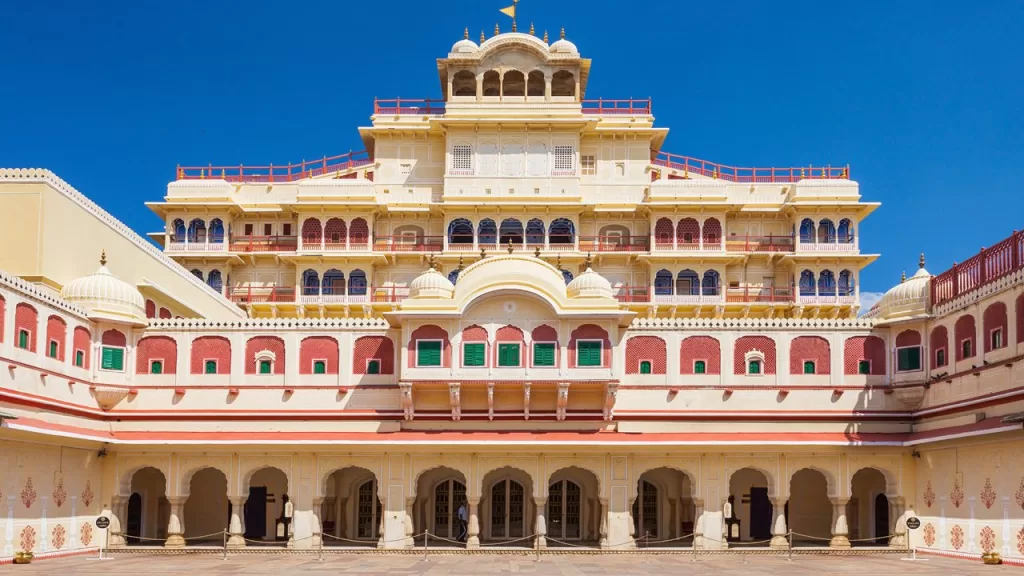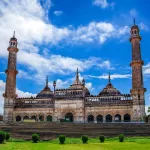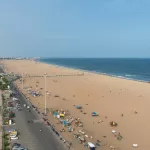City Palace Jaipur: A Timeless Symbol of Royal Grandeur
A Royal Legacy in the Heart of Jaipur
Amidst the vibrant city of Jaipur, the City Palace stands as a magnificent testament to its royal heritage. Unlike many of Rajasthan’s famous hilltop forts, this architectural gem is situated just four kilometers from the railway station, nestled in the heart of the Pink City.
Built in 1727 by Maharaja Sawai Jai Singh II, the City Palace is a stunning blend of Rajasthani and Mughal architecture, reflecting the grandeur and refined taste of the Rajput rulers. Designed as part of Jaipur’s ambitious city project, the palace spans across a series of interconnected courtyards, halls, and galleries, each telling a story of its illustrious past. Over the centuries, successive rulers expanded and enhanced this breathtaking complex, transforming it into an enduring symbol of Jaipur’s rich cultural heritage.
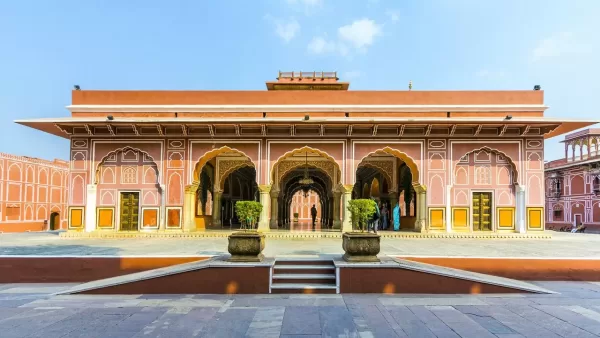
Beyond its role as a royal residence, the City Palace served as a center for art, learning, and religious devotion. Its many temples have long been integral to the city’s most celebrated festivals, fostering a deep connection between the palace and the people of Jaipur. Today, the palace welcomes visitors from around the world, offering an immersive experience into the legacy and splendor of Rajasthan’s royal lineage.
The Vision Behind the Palace
The foundation of the City Palace was a bold and strategic decision by Maharaja Sawai Jai Singh II, who envisioned a grand new capital beyond the historic town of Amer and its famed Amber Fort. As Jaipur’s population grew and water resources became scarce, the need for a larger and more sustainable city became evident.
ALSO READ: Bara Imambara: A Marvel of Mughal Architecture in Lucknow
To bring his vision to life, the Maharaja enlisted the expertise of two renowned architects—Vidhyadhar Bhattacharya, a master of Indian architecture, and Sir Samuel Swinton Jacob, a distinguished British engineer. Together, they crafted a masterpiece that would stand as a symbol of Rajput grandeur for centuries to come. Today, the City Palace remains one of Rajasthan’s most iconic landmarks, drawing visitors from across the globe to witness its architectural brilliance and historical significance.
Inside the City Palace: A Journey Through History
Stepping through the grand Virendra Pol, visitors enter the palace’s first courtyard, where the elegant Mubarak Mahal stands. This cream-colored haveli, once used as a reception hall, is adorned with intricate carvings, graceful arches, and beautifully designed pillars. Today, it houses part of the Maharaja Sawai Man Singh II Museum, showcasing an exquisite collection of royal artifacts.
To the right of Mubarak Mahal, the Rajendra Pol, a striking marble gateway, invites guests deeper into the palace’s grandeur. Beyond this gate lies the Diwan-E-Khas, the central courtyard, an awe-inspiring space adorned with crystal chandeliers, pristine marble floors, and grand red-stone archways. This historic hall was once a place for royal audiences, where the Maharajas held important meetings and ceremonial gatherings.
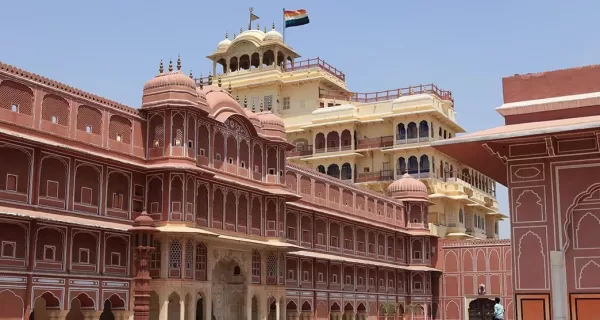
Festivals and Cultural Celebrations
The City Palace comes alive during Jaipur’s vibrant festivals, offering visitors a chance to witness Rajasthan’s royal traditions firsthand. One of the most spectacular events is the Teej Festival, where a grand procession carries an idol of Goddess Parvati through the palace, accompanied by music and traditional performances.
During Dussehra, the palace courtyards resonate with age-old rituals as royal men pay homage to their ancestral armory. The festival of Gangaur, dedicated to Maa Gauri (a form of Goddess Durga), is especially significant for women, who celebrate it with elaborate rituals and processions.
Beyond these, visitors can experience the grandeur of the palace during Holi, Diwali, and Makar Sankranti, immersing themselves in Rajasthan’s deep-rooted cultural heritage. These festivals transform the City Palace into a breathtaking spectacle of lights, colors, and traditions, making it a must-visit destination for anyone seeking to experience Jaipur’s royal legacy.
With its majestic architecture, rich history, and vibrant cultural traditions, the City Palace remains a captivating gateway into the world of Rajput royalty, preserving the essence of Jaipur’s soul for generations to come.
Inside the Lives of Jaipur’s Royals
Rising above the City Palace complex, the Chandra Mahal or ‘Moon Palace’ stands as a magnificent seven-story structure that embodies the grandeur of Jaipur’s royal legacy. This opulent palace is not just an architectural wonder but also a living residence, still home to the present-day royal family.
The first floor of Chandra Mahal is open to visitors as part of the Maharaja Sawai Man Singh II Museum. Where an extraordinary collection of royal artifacts awaits. From antique weaponry and centuries-old manuscripts to exquisite carpets, delicate blue pottery, and intricate Indian artwork. Each exhibit offers a glimpse into the artistic and cultural richness of Rajasthan’s regal past.
For a deeper insight into the private world of the royals. One must ascend to the upper levels of Chandra Mahal. The second floor houses Sukh Niwas, or the ‘Blue Room,’. A royal dining hall adorned with vibrant blue walls and elegant white detailing. The third and fourth floors reveal two breathtaking halls—the Rang Mandir. Also known as the ‘Mirror Room,’ and Shobha Niwas, or the ‘Hall of Beauty.’ Both are adorned with ornate mirror work and exquisitely designed tiles. Making them among the most mesmerizing spaces within the palace.
Further up, the fifth floor is home to Chavi Niwas, once the Maharaja’s personal retreat. The sixth and seventh floors, known as Shri Niwas and Mukut Niwas. Offer unparalleled panoramic views of Jaipur, making them the crowning jewels of this regal residence.
While a standard ticket grants access to the museum on the first floor. Visitors seeking an exclusive experience can opt for the ‘Royal Splendour’ ticket. Which allows entry into these restricted royal chambers.
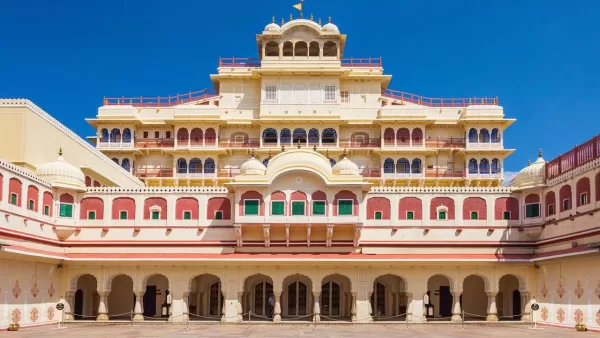
Beyond the City Palace: Jaipur’s Cultural Treasures
While the City Palace is the heart of Jaipur’s regal charm. The Pink City is home to several other spectacular attractions that complete the royal experience.
Not far from the palace, the imposing Amber Fort stands tall over Maota Lake. Once serving as the seat of power for the Rajput rulers of this region. A short walk away lies the Jantar Mantar, an extraordinary observatory built by Maharaja Sawai Jai Singh II. Showcasing Jaipur’s scientific and astronomical heritage through its remarkable collection of instruments.
And for those eager to soak in the vibrant essence of Jaipur. A stroll through the city’s bustling bazaars is a must. As you explore the lively streets filled with traditional crafts and textiles. Don’t miss the chance to enjoy a cup of chai at a rooftop cafe. Offering breathtaking views of the iconic Hawa Mahal.
Together, these remarkable sites weave a rich cultural tapestry, seamlessly complementing the grandeur and allure of the City Palace.
Step Into Jaipur’s Royal Legacy
Embark on a captivating journey through Rajasthan’s royal past at the magnificent City Palace. Discover the luxurious lives of Jaipur’s royals. Explore stunning palaces, and immerse yourself in the timeless beauty of this regal city.
